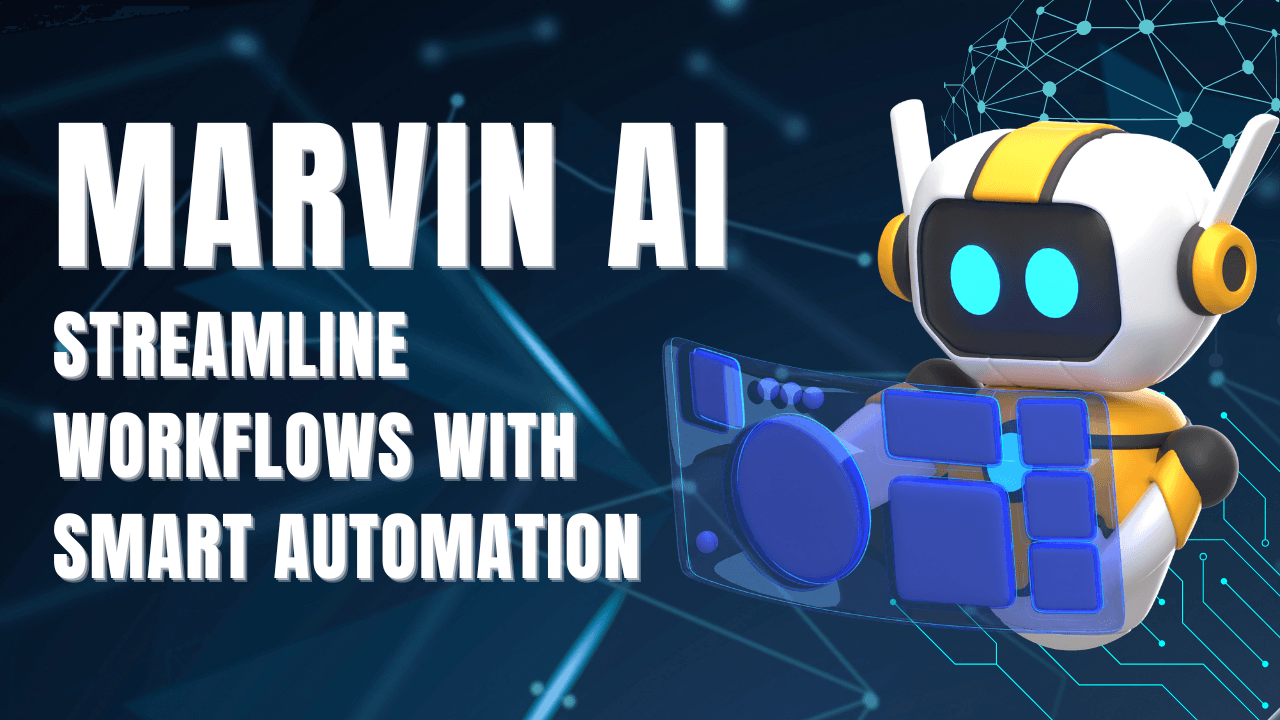Marvin AI: Streamline Workflows with Smart Automation
Marvin is an AI framework that enhances workflows with classification, data transformation, feature extraction, and automation. It enables structured data generation, sentiment analysis, and multimedia creation. This guide explores its key features, real-world applications, and seamless integration.

Do you want to be remembered as someone who waited or someone who created?
Gen AI Launch Pad 2025 is your platform to innovate.
Introduction
Marvin is a powerful AI framework designed to enhance productivity and automation by providing a task-centric architecture, multi-agent orchestration, and seamless ecosystem integration. Whether you are classifying text, transforming data, generating structured outputs, or even creating AI-driven audio and images, Marvin offers a robust suite of tools to streamline your workflow.
This guide will take an in-depth look at the capabilities of Marvin, providing detailed explanations of its core features along with real-world applications. By the end of this blog, you will have a solid understanding of how to integrate Marvin into your projects, optimizing efficiency and leveraging AI-driven automation.
Getting Started with Marvin
Before diving into Marvin’s functionalities, let us begin by setting up the required dependencies and installing the necessary packages.
Installation
To get started with Marvin, install the package using pip. Additionally, install pydub to handle audio features and pyaudio for text-to-speech functionalities.
pip install marvin pydub !apt-get install -y portaudio19-dev !pip install pyaudio pip install "marvin[audio]"
These dependencies are essential for enabling Marvin’s multimodal capabilities, including audio processing and AI-driven automation.
Setting Up API Keys
Marvin interacts with AI services that require authentication. To securely store and access your API key, use the following approach:
from google.colab import userdata
import os
os.environ['OPENAI_API_KEY'] = userdata.get('OPENAI_API_KEY')
This ensures that the API key is securely stored and accessed without hardcoding sensitive credentials into your scripts.
Text Classification with Marvin
Marvin simplifies text classification by allowing you to assign predefined labels to a given input. This feature is especially useful for tasks such as sentiment analysis, spam detection, and content categorization.
Code Example
import marvin
result = marvin.classify(
"Marvin is so easy to use!",
labels=["positive", "negative", "neutral"],
)
print(result)
Expected Output
positive
Explanation
- The
marvin.classify()function takes an input string and classifies it based on predefined labels. - In this example, the text is classified as "positive," indicating a favorable sentiment.
- This feature is commonly used in customer feedback analysis, social media sentiment tracking, and automated moderation systems.
Data Transformation with Marvin
Marvin enables seamless conversion of unstructured text into structured data formats, which is crucial for standardizing inputs and making data more actionable.
Code Example
import marvin
from pydantic import BaseModel
class Location(BaseModel):
city: str
state: str
location = marvin.cast("NYC", target=Location)
print(location)
Expected Output
city='New York City' state='New York'
Explanation
- The
marvin.cast()function converts the input text into a structured format based on a predefined schema. - This is particularly useful for applications that require data normalization, such as CRM systems and logistics applications.
Location Transformation with Custom Instructions
Users can specify instructions to customize how Marvin transforms text into structured outputs.
Code Example
import marvin
location = marvin.cast(
"NYC",
target=str,
instructions="Return the proper city and state name",
)
print(location)
Expected Output
New York City, New York
Use Cases
- Address standardization in databases.
- Ensuring consistency in location-based datasets.
- Improving geospatial analysis accuracy.
Feature Extraction with Marvin
Marvin enables users to extract key elements from text, which is useful for text analytics and NLP applications.
Code Example
import marvin
features = marvin.extract(
"I love my new phone's camera, but the battery life could be improved.",
instructions="extract product features",
)
print(features)
Expected Output
['camera', 'battery life']
Explanation
- This function is ideal for analyzing product reviews, extracting themes from customer feedback, and identifying key topics in text.
Generating Structured Data
Marvin can generate structured outputs based on user-defined parameters and schemas.
Code Example
import marvin
from pydantic import BaseModel
class Location(BaseModel):
city: str
state: str
locations = marvin.generate(
n=4,
target=Location,
instructions="US cities named after presidents",
)
print(locations)
Expected Output
[Location(city='Jefferson City', state='Missouri'), Location(city='Lincoln', state='Nebraska'), Location(city='Washington', state='D.C.'), Location(city='Madison', state='Wisconsin')]
Use Cases
- Automated content generation for datasets.
- Creating test data for simulations.
- Generating structured responses in chatbots.
AI Functions with Marvin
Marvin allows developers to define AI-powered functions using decorators, enabling automated analysis and predictions.
Code Example
import marvin
@marvin.fn
def sentiment(text: str) -> float:
"""
Returns a sentiment score for `text` on a
scale of -1.0 (negative) to 1.0 (positive)
"""
sentiment("I love Marvin!")
Expected Output
0.9
Explanation
- The
@marvin.fndecorator turns a Python function into an AI-enhanced function. - This is particularly useful for real-time sentiment scoring, automated content evaluation, and opinion mining.
Conclusion
Marvin provides a powerful suite of AI-driven tools that make data processing, classification, transformation, and multimedia generation easier. With its ability to integrate with existing workflows and provide structured outputs, Marvin is an essential tool for developers, researchers, and AI practitioners.
By leveraging Marvin’s capabilities, users can streamline workflows, enhance automation, and make data-driven decisions with greater efficiency. Whether working with text, audio, images, or structured data, Marvin offers an all-in-one solution for AI-driven development.
Resources
---------------------------
Stay Updated:- Follow Build Fast with AI pages for all the latest AI updates and resources.
Experts predict 2025 will be the defining year for Gen AI Implementation. Want to be ahead of the curve?
Join Build Fast with AI’s Gen AI Launch Pad 2025 - your accelerated path to mastering AI tools and building revolutionary applications.
---------------------------
Resources and Community
Join our community of 12,000+ AI enthusiasts and learn to build powerful AI applications! Whether you're a beginner or an experienced developer, this tutorial will help you understand and implement AI agents in your projects.
- Website: www.buildfastwithai.com
- LinkedIn: linkedin.com/company/build-fast-with-ai/
- Instagram: instagram.com/buildfastwithai/
- Twitter: x.com/satvikps
- Telegram: t.me/BuildFastWithAI
AI That Keeps You Ahead
Get the latest AI insights, tools, and frameworks delivered to your inbox. Join builders who stay ahead of the curve.

